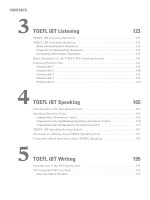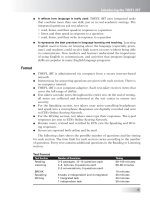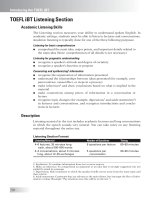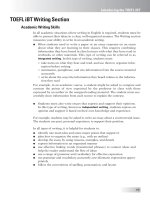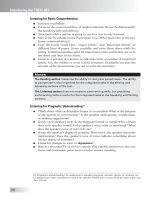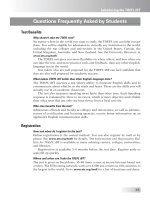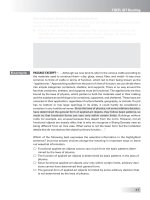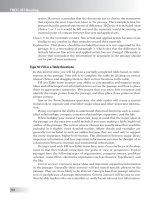Security+ guide to network security fundamentals, third edition
Bạn đang xem bản rút gọn của tài liệu. Xem và tải ngay bản đầy đủ của tài liệu tại đây (337.82 KB, 24 trang )
1428340661_ch00_Final.qxd
10/14/08
4:56 PM
Page i
Security+ Guide to Network
Security Fundamentals
Third Edition
Mark Ciampa
Australia • Brazil • Japan • Korea • Mexico • Singapore • Spain • United Kingdom • United States
1428340661_ch00_Final.qxd
10/14/08
Security+ Guide to Network Security
Fundamentals, Third Edition
Mark Ciampa
Vice President, Career and Professional
Editorial: Dave Garza
Executive Editor: Stephen Helba
Managing Editor: Marah Bellegarde
Senior Product Manager:
Michelle Ruelos Cannistraci
Developmental Editor: Deb Kaufmann
Editorial Assistant: Sarah Pickering
Vice President, Career and Professional
Marketing: Jennifer McAvey
6:02 PM
Page ii
© 2009 Course Technology, Cengage Learning
ALL RIGHTS RESERVED. No part of this work covered by the copyright herein
may be reproduced, transmitted, stored, or used in any form or by any means
graphic, electronic, or mechanical, including but not limited to photocopying,
recording, scanning, digitizing, taping, web distribution, information networks,
or information storage and retrieval systems, except as permitted under
Section 107 or 108 of the 1976 United States Copyright Act, without the prior
written permission of the publisher.
For product information and technology assistance, contact us at
Cengage Learning Customer & Sales Support, 1-800-354-9706
For permission to use material from this text or product,
submit all requests online at www.cengage.com/permissions
Further permissions questions can be e-mailed to
Marketing Director: Deborah S. Yarnell
Marketing Manager: Erin Coffin
Marketing Coordinator: Shanna Gibbs
Microsoft® is a registered trademark of the Microsoft Corporation. Security+ is
a registered trademark.
Production Director: Carolyn Miller
Library of Congress Control Number: 2008935589
Production Manager: Andrew Crouth
ISBN-13: 978-1-428-34066-4
Content Project Manager:
Jessica McNavich
ISBN-10: 1-428-34066-1
Art Director: Jack Pendleton
Cover photo or illustration:
www.istock.com
Technology Project Manager: Joseph Pliss
Course Technology
25 Thomson Place
Boston, MA 02210
USA
Copyeditor: Kathy Orrino
Cengage Learning is a leading provider of customized learning solutions with
office locations around the globe, including Singapore, the United Kingdom,
Australia, Mexico, Brazil, and Japan. Locate your local office at:
www.international.cengage.com/region
Proofreader: Brandy Lilly
Cengage Learning products are represented in Canada by Nelson Education, Ltd.
Compositor: International Typesetting
and Composition
For your lifelong learning solutions, visit www.course.cengage.com
Visit our corporate website at www.cengage.com
Manufacturing Coordinator:
Denise Powers
Some of the product names and company names used in this book have been used for identification purposes only and may be trademarks or registered trademarks of their respective manufacturers and sellers.
Microsoft and the Office logo are either registered trademarks or trademarks of Microsoft Corporation in the United States and/or other
countries. Course Technology, a part of Cengage Learning, is an independent entity from the Microsoft Corporation, and not affiliated with
Microsoft in any manner.
Any fictional data related to persons or companies or URLs used throughout this book is intended for instructional purposes
only. At the time this book was printed, any such data was fictional and not belonging to any real persons or companies.
®
Course Technology, the Course Technology logo, and the Shelly Cashman Series are registered trademarks used under license.
Adobe, the Adobe logos, Authorware, ColdFusion, Director, Dreamweaver, Fireworks, FreeHand, JRun, Flash, and Shockwave are
either registered trademarks or trademarks of Adobe Systems Incorporated in the United States and/or other countries. All other
names used herein are for identification purposes only and are trademarks of their respective owners.
Course Technology, a part of Cengage Learning, reserves the right to revise this publication and make changes from time to time in
its content without notice.
The programs in this book are for instructional purposes only. They have been tested with care, but are not guaranteed for any
particular intent beyond educational purposes. The author and the publisher do not offer any warranties or representations, nor do
they accept any liabilities with respect to the programs.
Printed in Canada
1 2 3 4 5 6 7 12 11 10 09 08
1428340661_ch00_Final.qxd
10/15/08
10:46 AM
Page iii
Brief Contents
INTRODUCTION
CHAPTER 1
Introduction to Security
xiii
1
Security+ Domain 1.0: Systems Security
CHAPTER 2
Systems Threats and Risks
39
CHAPTER 3
Protecting Systems
79
Security+ Domain 2.0: Network Infrastructure
CHAPTER 4
Network Vulnerabilities and Attacks
119
CHAPTER 5
Network Defenses
153
CHAPTER 6
Wireless Network Security
189
Security+ Domain 3.0: Access Control
CHAPTER 7
Access Control Fundamentals
225
CHAPTER 8
Authentication
265
Security+ Domain 4.0: Assessments & Audits
CHAPTER 9
Performing Vulnerability Assessments
301
CHAPTER 10
Conducting Security Audits
331
Security+ Domain 5.0: Cryptography
CHAPTER 11
Basic Cryptography
365
CHAPTER 12
Applying Cryptography
399
Security+ Domain 6.0: Organizational Security
CHAPTER 13
Business Continuity
439
CHAPTER 14
Security Policies and Training
477
iii
1428340661_ch00_Final.qxd
iv
10/14/08
4:56 PM
Page iv
Brief Contents
APPENDIX A
CompTIA Security+ 2008 Examination Objectives
509
APPENDIX B
Security Web Sites
517
APPENDIX C
Selected TCP/IP Ports and Their Threats
523
APPENDIX D
Sample Internet and E-Mail Acceptable Use Policy
527
INDEX
533
1428340661_ch00_Final.qxd
10/14/08
4:56 PM
Page v
Table of Contents
INTRODUCTION
CHAPTER 1
Introduction to Security
Challenges of Securing Information
Today’s Security Attacks
Difficulties in Defending against Attacks
xiii
1
3
3
7
What Is Information Security?
Defining Information Security
Information Security Terminology
Understanding the Importance of Information Security
9
9
11
13
Who Are the Attackers?
Hackers
Script Kiddies
Spies
Employees
Cybercriminals
Cyberterrorists
16
16
16
17
17
17
18
Attacks and Defenses
Steps of an Attack
Defenses against Attacks
Layering
Limiting
Diversity
Obscurity
Simplicity
19
19
20
20
21
21
22
22
Surveying Information Security Careers and the Security+ Certification
Types of Information Security Jobs
CompTIA Security+ Certification
22
22
24
Chapter Summary
24
Key Terms
25
Review Questions
26
Hands-on Projects
30
Case Projects
35
CHAPTER 2
Systems Threats and Risks
39
Software-Based Attacks
Infecting Malware
Concealing Malware
Malware for Profit
41
41
44
48
Hardware-Based Attacks
BIOS
USB Devices
Network Attached Storage (NAS)
Cell Phones
55
55
55
56
58
Attacks on Virtualized Systems
What Is Virtualization?
Attacks on Virtual Systems
59
59
61
v
1428340661_ch00_Final.qxd
vi
10/14/08
4:56 PM
Page vi
Table of Contents
Chapter Summary
63
Key Terms
64
Review Questions
67
Hands-on Projects
70
Case Projects
76
CHAPTER 3
Protecting Systems
79
Hardening the Operating System
Managing Operating System Updates
Buffer Overflow Protection
Configuring Operating System Protection
81
81
85
88
Preventing Attacks that Target the Web Browser
Cookies
JavaScript
Java
ActiveX
Cross Site Scripting (XSS)
89
89
90
91
92
93
Hardening Web Servers
95
Protecting Systems from Communications-Based Attacks
SMTP Open Relays
Instant Messaging
Peer-to-Peer (P2P) Networks
97
97
98
99
Applying Software Security Applications
Antivirus
Popup Blockers
Anti-Spam
Personal Software Firewalls
Host Intrusion Detection Systems (HIDS)
100
100
100
101
103
103
Chapter Summary
104
Key Terms
105
Review Questions
107
Hands-on Projects
110
Case Projects
117
CHAPTER 4
Network Vulnerabilities and Attacks
119
Network Vulnerabilities
Media-Based Vulnerabilities
Network Device Vulnerabilities
121
121
123
Categories of Attacks
Denial of Service (DoS)
Spoofing
Man-in-the-Middle
Replay
126
126
130
130
131
Methods of Network Attacks
Protocol-Based Attacks
Wireless Attacks
Other Attacks and Frauds
131
131
137
141
1428340661_ch00_Final.qxd
10/14/08
4:56 PM
Page vii
Table of Contents
vii
Chapter Summary
142
Key Terms
143
Review Questions
145
Hands-on Projects
148
Case Projects
151
CHAPTER 5
Network Defenses
153
Crafting a Secure Network
Security through Network Design
Security through Network Technologies
155
155
162
Applying Network Security Devices
Firewall
Proxy Server
Honeypot
Network Intrusion Detection Systems (NIDS)
165
166
169
170
171
Host and Network Intrusion Prevention Systems (HIPS/NIPS)
172
Protocol Analyzers
173
Internet Content Filters
174
Integrated Network Security Hardware
174
Chapter Summary
175
Key Terms
176
Review Questions
177
Hands-on Projects
180
Case Projects
186
CHAPTER 6
Wireless Network Security
189
IEEE 802.11 Wireless Security Protections
Controlling Access
191
192
Vulnerabilities of IEEE 802.11 Security
Open System Authentication Vulnerabilities
MAC Address Filtering Weaknesses
WEP
198
198
200
200
Personal Wireless Security
WPA Personal Security
WPA2 Personal Security
202
202
204
Enterprise Wireless Security
IEEE 802.11i
WPA Enterprise Security
WPA2 Enterprise Security
Enterprise Wireless Security Devices
206
206
207
209
209
Chapter Summary
214
Key Terms
215
Review Questions
216
Hands-on Projects
219
Case Projects
223
1428340661_ch00_Final.qxd
viii
10/14/08
4:56 PM
Page viii
Table of Contents
CHAPTER 7
Access Control Fundamentals
225
What Is Access Control?
Access Control Terminology
Access Control Models
Practices for Access Control
227
227
229
233
Logical Access Control Methods
Access Control Lists (ACLs)
Group Policies
Account Restrictions
Passwords
234
234
236
236
238
Physical Access Control
Computer Security
Door Security
Mantraps
Video Surveillance
Physical Access Log
244
244
245
248
249
249
Chapter Summary
250
Key Terms
251
Review Questions
253
Hands-on Projects
256
Case Projects
263
CHAPTER 8
Authentication
265
Definition of Authentication
Authentication and Access Control Terminology
Authentication, Authorization, and Accounting (AAA)
267
267
267
Authentication Credentials
One-Time Passwords
Standard Biometrics
Behavioral Biometrics
Cognitive Biometrics
Authentication Models
Authentication Servers
RADIUS
Kerberos
Terminal Access Control Access Control System (TACACS+)
Lightweight Directory Access Protocol (LDAP)
268
268
270
271
273
275
278
278
280
280
281
Extended Authentication Protocols (EAP)
Authentication Legacy Protocols
EAP Weak Protocols
EAP Strong Protocols
282
282
283
283
Remote Authentication and Security
Remote Access Services (RAS)
Virtual Private Networks (VPNs)
Remote Access Policies
284
284
284
287
Chapter Summary
287
Key Terms
288
Review Questions
291
1428340661_ch00_Final.qxd
10/14/08
4:56 PM
Page ix
Table of Contents
ix
Hands-on Projects
294
Case Projects
298
CHAPTER 9
Performing Vulnerability Assessments
301
Risk Management, Assessment, and Mitigation
What Is Risk?
Definition of Risk Management
Steps in Risk Management
303
303
304
304
Identifying Vulnerabilities
Vulnerability Scanning
Port Scanners
Network Mappers
Protocol Analyzers
Vulnerability Scanners
Open Vulnerability and Assessment Language (OVAL)
Password Crackers
Penetration Testing
312
312
312
314
316
317
318
319
321
Chapter Summary
322
Key Terms
323
Review Questions
324
Hands-on Projects
327
Case Projects
330
CHAPTER 10
Conducting Security Audits
331
Privilege Auditing
Privilege Management
Assigning Privileges
Auditing System Security Settings
333
333
334
334
Usage Auditing
338
Monitoring Methodologies and Tools
Methodologies for Monitoring
Monitoring Tools
348
348
349
Chapter Summary
350
Key Terms
351
Review Questions
352
Hands-on Projects
356
Case Projects
362
CHAPTER 11
Basic Cryptography
365
Defining Cryptography
What Is Cryptography?
Cryptography and Security
367
367
369
Cryptographic Algorithms
Hashing Algorithms
Message Digest (MD)
371
371
373
1428340661_ch00_Final.qxd
x
10/14/08
4:56 PM
Page x
Table of Contents
Secure Hash Algorithm (SHA)
Whirlpool
Password Hashes
Symmetric Cryptographic Algorithms
Other Algorithms
Asymmetric Cryptographic Algorithms
RSA
Diffie-Hellman
Elliptic Curve Cryptography
374
374
375
375
381
381
385
385
386
Using Cryptography on Files and Disks
File and File System Cryptography
Disk Cryptography
386
386
387
Chapter Summary
388
Key Terms
389
Review Questions
391
Hands-on Projects
394
Case Projects
398
CHAPTER 12
Applying Cryptography
399
Digital Certificates
Defining Digital Certificates
Authorizing, Storing, and Revoking Digital Certificates
Types of Digital Certificates
401
401
403
405
Public Key Infrastructure (PKI)
What Is Public Key Infrastructure (PKI)?
Public-Key Cryptographic Standards (PKCS)
Trust Models
Managing PKI
410
410
411
413
416
Key Management
Key Storage
Key Usage
Key Handling Procedures
417
418
418
418
Cryptographic Transport Protocols
File Transfer Protocols
Web Protocols
VPN Protocols
E-mail Transport Protocol
420
420
422
422
427
Chapter Summary
427
Key Terms
428
Review Questions
430
Hands-on Projects
433
Case Projects
436
CHAPTER 13
Business Continuity
439
Environmental Controls
Fire Suppression
Electromagnetic Shielding
HVAC
441
441
445
446
1428340661_ch00_Final.qxd
10/14/08
4:56 PM
Page xi
Table of Contents
xi
Redundancy Planning
Servers
Storage
Networks
Power
Sites
446
446
447
451
451
452
Disaster Recovery Procedures
Planning
Disaster Exercises
Data Backups
452
452
455
455
Incident Response Procedures
What Is Forensics?
Responding to a Computer Forensics Incident
459
459
460
Chapter Summary
464
Key Terms
465
Review Questions
467
Hands-on Projects
470
Case Projects
475
CHAPTER 14
Security Policies and Training
477
Organizational Security Policies
What Is a Security Policy?
Balancing Trust and Control
Designing a Security Policy
479
479
480
481
Types of Security Policies
Acceptable Use Policy (AUP)
Security-Related Human Resource Policy
Password Management and Complexity Policy
Personally Identifiable Information (PII) Policy
Disposal and Destruction Policy
Service Level Agreement (SLA) Policy
Classification of Information Policy
Change Management Policy
Ethics Policy
485
486
487
487
488
489
489
490
490
491
Education and Training
Organizational Training
Reducing Risks of Social Engineering
492
492
494
Chapter Summary
498
Key Terms
499
Review Questions
500
Hands-on Projects
503
Case Projects
507
APPENDIX A
CompTIA Security+ 2008 Examination Objectives
509
APPENDIX B
Security Web Sites
517
Security Organizations
517
Vendor Security Web Sites
518
1428340661_ch00_Final.qxd
xii
10/14/08
4:56 PM
Page xii
Table of Contents
Threat Analysis
518
Standards Organizations and Regulatory Agencies
519
Laws Protecting Private Information
519
Blogs
520
APPENDIX C
Selected TCP/IP Ports and Their Threats
523
APPENDIX D
Sample Internet and E-Mail Acceptable Use Policy
527
INDEX
College Z Department of Computer Information Systems Internet and E-Mail Acceptable Use Policy
527
Organization ABC Acceptable Use Policy
1.0 Overview
2.0 Purpose
3.0 Scope
4.0 Policy
5.0 Enforcement
6.0 Definitions
7.0 Revision History
530
530
530
530
530
532
532
532
533
1428340661_ch00_Final.qxd
10/14/08
4:56 PM
Page xiii
Introduction
Security continues to be the number one concern of computer professionals today, and with
good reason. Consider the evidence: as many as 150 million computers worldwide may be
remotely controlled by attackers. Over 94 million credit and debit cards were compromised in
one data security breach with losses totaling over $140 million. On average, every 39 seconds
your computer is probed by attackers looking for vulnerabilities. One out of every 25 e-mails
contains a virus. An organization on average receives 13.6 attacks each day. There are almost
8 million computer viruses on the loose. The median dollar loss for victims of ID theft is over
$31,000. The number of US federal agencies that recently received a grade “F” on security is
now eight. Over 15,000 freshly infected Web pages appear every day, and an unsuspecting user
who only views one of these infected sites through their Web browser and does not even click
on a link will find their computer infected. And over 1,500 users still respond to the “Nigerian
General” spam each week.
As attacks continue to escalate, the need for trained security personnel also increases.
Worldwide, the number of information security professionals will grow from 1.6 million in
2007 to 2.7 million in 2012, experiencing a compound annual growth rate of 10 percent.
And unlike some information technology computer positions, security is not being offshored
and is rarely outsourced.
Yet security personnel cannot be part of an “on-the-job training” program where an individual learns as they go; the risk is simply too great. Instead, many employers are requiring
employees and job applicants to demonstrate their security knowledge and skills by possessing a security certification, such as the CompTIA Security+ certification. The Department of
Defense Directive 8570 requires 110,000 information assurance professionals in assigned
duty positions to have security certification within five years, and it also requires certification
of all 400,000 full- and part-time military service members, contractors, and local nationals
who are performing information assurance functions to be certified in security. And IT
employers are willing to pay a premium for certified security personnel. Security certifications
earn employees 10 percent to 14 percent more pay than their uncertified counterparts.
It is critical that computer users of all types understand how to protect themselves and
their organizations from attacks. It is also important that individuals who want a job in the
ever-growing field of information security be certified. Security+ Guide to Network Security
Fundamentals, Third Edition is designed to meet both of these needs. This book takes a comprehensive view of the types of attacks that are launched against networks and computer systems. It examines computer security defense mechanisms, and offers practical tools, tips, and
techniques to counter attackers. Security+ Guide to Network Security Fundamentals, Third
Edition helps you defend against attackers and protect the most precious resource of all computer users and organizations—information. In addition, this book is a valuable tool for
those who want to enter the field of information security. It provides you with the knowledge
and skills that will help you prepare for the CompTIA Security+ certification exam.
Intended Audience
This book is intended to meet the needs of students and professionals who want to master
practical network and computer security. A basic knowledge of computers and networks is
all that is required to use this book. Those seeking to pass the Computing Technology
Industry Association (CompTIA) Security+ certification exam will find the text’s approach and
content especially helpful, because all Security+ 2008 exam objectives are covered. (For more
xiii
1428340661_ch00_Final.qxd
xiv
10/14/08
4:56 PM
Page xiv
Introduction
information on Security+ certification, visit CompTIA’s Web site at www.comptia.org.) Yet
Security+ Guide to Network Security Fundamentals, Third Edition is much more than an
examination prep book; it also covers all aspects of network and computer security while
satisfying the Security+ objectives.
The book’s pedagogical features are designed to provide a truly interactive learning experience to help prepare you for the challenges of network and computer security. In addition
to the information presented in the text, each chapter includes Hands-On Projects that guide
you through implementing practical hardware, software, network, and Internet security configurations step by step. Each chapter also contains a running case study that places you in
the role of problem solver, requiring you to apply concepts presented in the chapter to achieve
a successful solution.
Chapter Descriptions
Here is a summary of the topics covered in each chapter of this book:
Chapter 1, “Introduction to Security,” begins by explaining the challenge of information
security and why it is important. This chapter also introduces information security
terminology and defines who are the attackers. In addition, it explains the CompTIA
Security+ exam, and explores career options for those interested in mastering security skills.
Chapter 2, “System Threats and Risks,” examines the threats and risks that a computer
system faces by looking at both software-based attacks and attacks directed against the
computer hardware. It also examines the expanding world of virtualization and how
virtualized environments are increasingly becoming the target of attackers.
Chapter 3, “Protecting Systems,” examines the steps for protecting systems by looking
at steps that should be taken to harden the operating system, Web browser, Web servers,
and how to protect from communications-based attacks. It also explores the additional
security software applications that should be applied to systems.
Chapter 4, “Network Vulnerabilities and Attacks,” gives an overview of network security
by examining some of the major weaknesses that are found in network systems. It also
looks at the different categories of attacks and the methods of attacks that are commonly
unleashed against networks today.
Chapter 5, “Network Defenses,” examines how to create a secure network through
both network design and technologies and also how to apply network security tools
to resist attacker.
Chapters 6, “Wireless Network Security,” explores security in a wireless network
environment. It investigates the basic IEEE 802.11 security protections, the vulnerabilities
associated with these protections, and examines today’s enhanced WLAN security
protections for personal users as well as for enterprises.
Chapter 7, “Access Control Fundamentals,” introduces the principles and practices
of access control by examining access control terminology, the three standard control
models, and best practices. It also covers logical access control methods and explores
physical access control.
Chapter 8, “Authentication,” examines the definition of authentication and reviews
how it fits into access control. It explores authentication credentials and models, different
types of authentication servers and authentication protocols, and remote authentication
and security.
1428340661_ch00_Final.qxd
10/14/08
4:56 PM
Page xv
Introduction
xv
Chapter 9, “Performing Vulnerability Assessments ” begins a study of performing
vulnerability assessments. It defines risk and risk management and examines the components of risk management, and looks at ways to identify vulnerabilities so that adequate
protections can be made to guard assets.
Chapter 10, “Conducting Security Audits,” explores users’ auditing privileges, auditing
how subjects use those privileges, and monitoring tools and methods.
Chapter 11,“Basic Cryptography,” explores how encryption can be used to protect data.
It covers what cryptography is and how it can be used for protection, how to protect
data using three common types of encryption algorithms, and how to use cryptography
on file systems and disks to keep data secure.
Chapter 12, “Applying Cryptography,” looks at practical methods for applying cryptography to protect data. The chapter explores digital certificates and how they can be
used, public key infrastructure and key management, and how to use cryptography on
data that is being transported.
Chapter 13, “Business Continuity,” covers the critical importance of keeping business
processes and communications operating normally in the face of threats and disruptions.
It explores how to prevent disruptions through protecting resources with environmental
controls, and then looks at redundancy planning and disaster recovery procedures. Finally,
the chapter studies how incident response procedures are used when an unauthorized
event such as a security breach occurs.
Chapter 14, “Security Policies and Training,” looks at how organizations can establish
and maintain security. It begins with a study of security policies and the different types
of policies that are used, and then explores how education and training can help provide
the tools to users to maintain a secure environment within the organization.
Appendix A, “CompTIA Security+ Examination Objectives,” provides a complete listing
of the CompTIA Security+ 2008 certification exam objectives and shows the chapters in
the book that cover material associated with each objective.
Appendix B, “Security Web Sites,” offers a listing of several important Web sites that
contain security-related information.
Appendix C, “Selected TCP/IP Ports and Their Threats,” lists common TCP ports and
their security vulnerabilities.
Appendix D, “Sample Acceptable Use Policy,” gives a comprehensive example of two
acceptable use policies.
Features
To aid you in fully understanding computer and network security, this book includes many
features designed to enhance your learning experience.
• Maps to CompTIA Objectives. The material in this text covers all of the CompTIA
Security+ 2008 exam objectives. In addition, the sequence of material follows closely
the six Security+ domains.
• Chapter Objectives. Each chapter begins with a detailed list of the concepts to be
mastered within that chapter. This list provides you with both a quick reference to the
chapter’s contents and a useful study aid.
1428340661_ch00_Final.qxd
xvi
10/14/08
4:56 PM
Page xvi
Introduction
• Today’s Attacks and Defenses. Each chapter opens with a vignette of an actual security
attack or defense mechanism that helps to introduce the material covered in that chapter.
• Illustrations and Tables. Numerous illustrations of security vulnerabilities, attacks, and
defenses help you visualize security elements, theories, and concepts. In addition, the
many tables provide details and comparisons of practical and theoretical information.
• Chapter Summaries. Each chapter’s text is followed by a summary of the concepts
introduced in that chapter. These summaries provide a helpful way to review the ideas
covered in each chapter.
• Key Terms. All of the terms in each chapter that were introduced with bold text are
gathered in a Key Terms list with definitions at the end of the chapter, providing
additional review and highlighting key concepts.
• Review Questions. The end-of-chapter assessment begins with a set of review questions that reinforce the ideas introduced in each chapter. These questions help you
evaluate and apply the material you have learned. Answering these questions will
ensure that you have mastered the important concepts and provide valuable practice
for taking CompTIA’s Security+ exam.
• Hands-On Projects. Although it is important to understand the theory behind network
security, nothing can improve upon real-world experience. To this end, each chapter
provides several Hands-On Projects aimed at providing you with practical security
software and hardware implementation experience. These projects cover Windows
Vista and Windows Server 2008 operating systems, as well as software downloaded
from the Internet.
• Case Projects. Located at the end of each chapter are several Case Projects. In these
extensive exercises, you implement the skills and knowledge gained in the chapter
through real design and implementation scenarios.
Text and Graphic Conventions
Wherever appropriate, additional information and exercises have been added to this book to
help you better understand the topic at hand. Icons throughout the text alert you to additional materials. The icons used in this textbook are described below.
The Note icon draws your attention to additional helpful material
related to the subject being described.
Tips based on the authors’ experience provide extra information about
how to attack a problem or what to do in real-world situations.
The Caution icons warn you about potential mistakes or problems,
and explain how to avoid them.
1428340661_ch00_Final.qxd
10/14/08
4:56 PM
Page xvii
Introduction
xvii
Each Hands-on activity in this book is preceded by the Hands-on icon
and a description of the exercise that follows.
Case Project icons mark Case Projects, which are scenario-based
assignments. In these extensive case examples, you are asked to
implement independently what you have learned.
Test Preparation Software CD-ROM
Security+ Guide to Network Security Fundamentals, Third Edition includes the exam objectives coverage map in Appendix A, as well as CertBlaster test preparation software from dti
Publishing Corporation. CertBlaster software provides 290 sample exam questions that mirror
the look and feel of the Security+ exam. The unlock code for the CertBlaster questions is:
c_sec+08 (case sensitive). For more information about dti test prep products, visit the Web site
at www.dtipublishing.com.
Information Security Community Site
New to this edition is the Information Security Community Site. This site was created for students and instructors to find out about the latest in information security news and technology.
Visit www.community.cengage.com/infosec to:
❑ Learn what’s new in information security through live news feeds, videos and podcasts.
❑ Connect with your peers and security experts through blogs and Ask the Author forums.
❑ Download student and instructor resources, such as additional labs, instructional
videos, and instructor materials.
❑ Browse our online catalog.
Instructor’s Materials
The following additional materials are available when this book is used in a classroom setting. All of the supplements available with this book are provided to the instructor on a single
CD-ROM (ISBN: 1428340718). You can also retrieve these supplemental materials from the
Course Technology Web site, www.course.com, by going to the page for this book, under
“Download Instructor Files & Teaching Tools”.
Electronic Instructor’s Manual. The Instructor’s Manual that accompanies this textbook
includes the following items: additional instructional material to assist in class preparation,
including suggestions for lecture topics, tips on setting up a lab for the Hands-On Projects,
and solutions to all end-of-chapter materials.
ExamView Test Bank. This Windows-based testing software helps instructors design
and administer tests and pre-tests. In addition to generating tests that can be printed and
administered, this full-featured program has an online testing component that allows
students to take tests at the computer and have their exams automatically graded.
PowerPoint Presentations. This book comes with a set of Microsoft PowerPoint slides
for each chapter. These slides are meant to be used as a teaching aid for classroom
1428340661_ch00_Final.qxd
xviii
10/14/08
4:56 PM
Page xviii
Introduction
presentations, to be made available to students on the network for chapter review, or
to be printed for classroom distribution. Instructors are also at liberty to add their own
slides for other topics introduced.
Figure Files. All of the figures and tables in the book are reproduced on the Instructor
Resources CD. Similar to PowerPoint presentations, these are included as a teaching aid
for classroom presentation, to make available to students for review, or to be printed for
classroom distribution.
Total Solutions for Security
Lab Manual for Security+ Guide to Network Security Fundamentals, 3e (ISBN: 142834067X)
❑ Companion to Security+ Guide to Network Security Fundamentals, Third Edition.
This Lab Manual contains over 65 labs to provide students with additional hands-on
experience and to help prepare for the Security+ exam.
Virtualization Labs for Security (ISBN: 143544759X)
❑ This Lab Manual uses virtualized operating systems to teach students in a secure environment about attack and defense tools, different aspects of security applications, and
how operating systems become vulnerable to attackers.
LabSim for Security+ (ISBN: 1428340688 )
❑ Lab simulations, demonstrations, video presentations and test preparation reinforce
hands-on security skills. LabSim allows you to simulate hardware and operating systems on your computer without the need of additional hardware or software.
Security+ Web-Based Labs (ISBN: 142837695X)
❑ Using a real lab environment over the Internet, students can log on anywhere, anytime via a Web browser to gain essential hands-on experience in security using labs
from Security+ Guide to Network Security Fundamentals, 3e.
Security+ CourseNotes (ISBN: 1435401255)
❑ Laminated quick reference card with vital information for CompTIA’s Security+
exam, useful as a study aid, supplement to the textbook, or as a quick reference.
WebCT/BB
❑ Web CT and Blackboard are the leading distance learning solutions available today.
Course Technology provides online content that fits into both platforms and includes
the following components:
❑ Topic reviews
❑ Lecture notes
❑ Case projects
❑ Test banks
❑ Practice exams
❑ Custom syllabus, and more
1428340661_ch00_Final.qxd
10/15/08
10:46 AM
Page xix
Introduction
xix
What’s New with Comptia Security+ Certification
The CompTIA Security+ exam was updated in October 2008 and is based on new Security+
exam objectives. There are several significant changes to the exam objectives. The number of
exam objectives has been increased from five to six domains: Systems Security, Network
Infrastructure, Access Control, Assessments and Audits, Cryptography, and Organizational
Security. The new domain, Assessments and Audits, was added to address the importance of
risk assessment and mitigation, as well as to cover the tools and techniques in addressing risk.
In addition, each of the other domains has been reorganized and expanded to more accurately reflect current security issues and knowledge requirements. Finally, the exam objectives
now place more importance on knowing “how to” rather than just knowing or recognizing
security concepts. Here are the domains covered on the new Security+ exam:
Domain
CompTIA Security+
Chapters in This Book
1.0 Systems Security
21%
2, 3
2.0 Network Infrastructure
20%
4, 5, 6
3.0 Access Control
17%
7, 8
4.0 Assessments & Audits
15%
9, 10
5.0 Cryptography
15%
11, 12
6.0 Organizational Security
12%
13, 14
How to Become CompTIA Certified
In order to become CompTIA certified, you must:
1. Select a testing center and a certification exam provider. For more information, visit the
following Web site: />2. Register for and schedule a time to take the CompTIA certification exam at a convenient
location.
3. Take and pass the CompTIA certification exam.
For more information about CompTIA’s certifications, please visit .
CompTIA is a non-profit information technology (IT) trade association.
To contact CompTIA with any questions or comments, call (630) 678-8300 or send an e-mail
to The Computing Technology
Industry Association (CompTIA) is the voice of the world’s information technology (IT) industry. Its members are the companies at the forefront of innovation; and the professionals responsible for maximizing the benefits organizations receive from their investments in technology.
CompTIA is dedicated to advancing industry growth through its educational programs,
market research, networking events, professional certifications, and public policy advocacy.
CompTIA is a not-for-profit trade information technology (IT) trade association. CompTIA’s
certifications are designed by subject matter experts from across the IT industry. Each
CompTIA certification is vendor-neutral, covers multiple technologies and requires demonstration of skills and knowledge widely sought after by the IT industry.
1428340661_ch00_Final.qxd
xx
10/15/08
4:59 PM
Page xx
Introduction
Acknowledgments
Although only the author’s name appears on the front cover of a book, it takes an entire
team of dedicated professionals to create the finished product. And the team that produced
this book was one of the very best. Executive Editor Stephen Helba once again showed his
excellent vision by formulating the scope and direction of this book. It is a true privilege to
be associated with Steve and his team. Senior Product Manager Michelle Cannistraci was
very supportive and helped keep this project moving forward. Technical Editor Nicole
Ashton carefully reviewed the book and identified many corrections. The team of peer
reviewers evaluated each chapter and provided very helpful suggestions and contributions.
Thanks to Scott Dawson, Spokane Community College, Dean Farwood, Heald College, Kim
Fish, Butler County Community College, and David Pope, Ozarks Technical College.
Special recognition goes to Developmental Editor Deb Kaufmann. Not enough can be said
about Deb. She was again superb at making suggestions, finding errors, taking care of all the
small details, and somehow turning my rough work into polished prose. Deb is a joy to work
with. Without question, Deb is simply the very best there is.
The entire Cengage/Course Technology staff was always very helpful and worked very
hard to create this finished product. I’m honored to be part of such an outstanding group of
professionals, and to these people and everyone on the team I extend my sincere thanks.
And finally, I want to thank my wonderful wife, Susan. Once again she provided patience,
support, and love to see me through yet another book project. I simply could not have done
any of it without her as my companion.
Dedication
To my wife, Susan, my sons and daughters-in-law Brian, Amanda, Greg and Megan, and my
new grandson Braden.
About the Author
Mark Ciampa is Assistant Professor of Computer Information Systems at Western Kentucky
University in Bowling Green, Kentucky, and holds a PhD from Indiana State University in
Digital Communications. Prior to this he was Associate Professor and served as the Director
of Academic Computing at Volunteer State Community College in Gallatin, Tennessee, for
20 years. Mark has worked in the IT industry as a computer consultant for the U.S. Postal
Service, the Tennessee Municipal Technical Advisory Service, and the University of Tennessee.
He is also the author of many Cengage/Course Technology textbooks, including CWNA
Guide to Wireless LANs 2ed, Guide to Wireless Communications, Security+ Guide to Network
Security Fundamentals 2ed, Security Awareness: Applying Practical Security In Your World,
and Networking BASICS.
1428340661_ch00_Final.qxd
10/14/08
4:56 PM
Page xxi
Introduction
xxi
Lab Requirements
To the User
This book should be read in sequence, from beginning to end. Each chapter builds upon those
that precede it to provide a solid understanding of networking security fundamentals. The
book may also be used to prepare for CompTIA’s Security+ certification exam. Appendix A
pinpoints the exact chapter in which a specific Security+ exam objective is located.
Hardware and Software Requirements
Following are the hardware and software requirements needed to perform the end-of-chapter Hands-on Projects.
• Microsoft Windows Vista
• Windows 2008 Server
• An Internet connection and Web browser
• Microsoft Office 2007 or Office 2003
• Microsoft Office Outlook
Specialized Requirements
Whenever possible, the needs for specialized requirements were kept to a minimum. The following chapter features specialized hardware:
• Chapter 3: An Active Directory environment and WSUS installed on a Windows
Server 2008 server.
Free Downloadable Software Is Required in the Following
Chapters:
Chapter 1:
• Secunia Software Inspector
• Microsoft Windows Malicious Software Removal Tool
Chapter 2:
• Microsoft RootkitRevealer
• SoftDD Keyboard Collector
• Irongeek Thumbscrew
• Microsoft Virtual PC 2007
• VMware Workstation
Chapter 3:
• GRC Securable
• EICAR AntiVirus Test File
• Microsoft Windows Vista Security Templates
• Microsoft Baseline Security Analyzer
1428340661_ch00_Final.qxd
xxii
10/14/08
4:56 PM
Page xxii
Introduction
Chapter 4:
• Wireshark
• NetStumbler
Chapter 6:
• KLC Consulting SMAC
Chapter 7:
• Ophcrack
• KeePass
Chapter 9:
• Nessus
• GFI LANguard
Chapter 10:
• ThreatFire
Chapter 11:
• MD5DEEP
• TrueCrypt
Chapter 12:
• Comodo E-mail Certificate
Chapter 13:
• Briggs Software Directory Snoop
Chapter 14:
• Heidi Eraser
1428340661_ch00_Final.qxd
10/14/08
4:56 PM
Page xxiii
Introduction
xxiii
Security Certification: Market Drivers in Today’s
Information Security Landscape
Contributed by Carol Balkcom, CompTIA Security+ Product Manager
We are seeing a rise in security training and certification today like never before. With companies incurring millions of dollars of potential liability in well-publicized security breaches,
organizations—especially in the financial and healthcare industries, and government—have
realized that they can no longer afford to have IT staff who are not proven and tested in the
latest information security technologies and practices.
Today we also see the impact of U.S. military requirements on certification: Both military
information assurance personnel and IT employees of government contractor companies who
have contracts with the military are required to be certifed, under the terms of their contracts.
Included are many types of companies, from software, to systems integrators, to manufacture
and service companies. This has implications for those who work for these companies, as well
as those who would like to seek employment with them. There are government agencies such
as the U.S. State Department that have special programs in place for their IT departments that
require certification for new hires, as well as continuing education requirements for existing
employees who want to be eligible for regular pay raises.
Evidence of the Need
Surveys show that criminal theft of information (with potentially disastrous consequences)
can be traced in many cases to human error, failure to have adequate security policies, or
failure to enforce existing policies. CompTIA security research published in 2008 showed
that 30% of the most severe security breaches were caused by human error.1 Almost 60%
of companies now require security training for IT staff, and roughly one-third of them now
require certification. Eighty-nine percent of CompTIA survey respondents said that security
certification had improved IT security. Without regular training and validation of knowledge, it is much more likely that employees in IT departments will lack the awareness or the
motivation to use the rigorous methods required to secure their networks and mobile
devices against intrusion.
“Vendor-Neutral” vs. “Vendor-Specific” Certification
When an IT professional decides to complement his or her experience with certification, a
vendor-neutral certification is often the first type of exam taken. A vendor-neutral exam is
one that tests for knowledge of a subject across platforms and products—without being tied
to any specific product—while validating baseline skills and knowledge in that subject area.
CompTIA exams are vendor-neutral exams and serve that portion of the IT population who
have a good foundation in their chosen field and want to become certified. Individuals who
take CompTIA Security+ are serious about their role in information security. They typically
have at least two years of hands-on technical security experience. They may have also taken
an exam like CompTIA Network+ as a first entry into certification.
1
Trends in Information Security: A CompTIA Analysis of IT Security and the Workforce, April 2008
1428340661_ch00_Final.qxd
xxiv
10/14/08
4:56 PM
Page xxiv
Introduction
Who Is Becoming Certified
There is a very long list of employers where significant numbers of staff in IT roles are becoming CompTIA Security+ certified. Here are some of the significant ones:
Booz Allen Hamilton, Hewlett-Packard, IBM, Motorola, Symantec, Telstra, Hitachi,
Ricoh, Lockheed Martin, Unisys, Hilton Hotels Corp., General Mills, U.S. Navy, Army, Air
Force and Marines.
While the majority of CompTIA Security+ certified professionals are in North America,
there are growing numbers in over 100 countries, with a solid and growing base especially in
Japan, the UK, Germany, South Africa and South Korea. The need for information security
training and certification has never been greater, and has become a worldwide issue.

